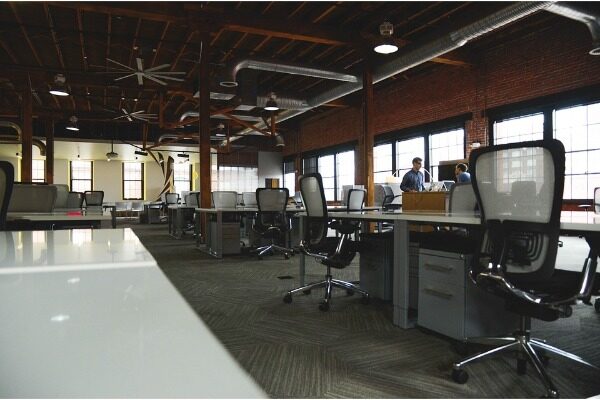Taking employees out of the traditional office setting is known as hot desking. By establishing breakout spaces, hot desks enable collaboration rather than erecting walls that make employees move around the office and become less productive. There can be significant increases in overall staff productivity when combined with contemporary technological elements.
For teams that are very mobile and rarely need to be in the office, it is quite advantageous. It is a good way to get everyone on the same page for teams that occasionally add telecommuters.
Before fully committing to this type of workspace design, hot desking has some benefits and drawbacks that should be taken into account.
What is Hot Desking?
Hot desking also referred to as desk sharing or desk hoteling, is a desk allocation and office design strategy in which employees don’t have their own desks. Instead, fewer desks are available overall, and, in accordance with corporate policy, either reserved seats or first-come, first-served seating is taken up.
This practice is justified by the need for businesses to adjust to shifting workplace norms and the rise of employees who at least occasionally work from home. Since all of an organization’s employees hardly ever gather in the office at once a more hybrid approach to work is adopted, and introducing hot desking makes more sense.
Hot desking has a number of benefits and drawbacks, just like any change to a company’s operations. Not only does it affect the price of materials, but it also has an impact on employee morale and company culture. The various advantages and disadvantages of hot desking are listed below.
Advantages of Hot Desking
It is An Affordable Way to Design An Office.
Hot desking uses less overall space than a typical office-style design when the open spacing is properly implemented. In addition to saving 15% to 25% on the amount of space they need, large teams may find that hot desking reduces their office operating costs by 30%.
It Creates An Open Design.
More collaboration within the team environment is facilitated by hot desking’s an open design. The layout can be entirely open, allowing constant contact between coworkers. Additionally, it can involve a certain amount of separation so that people can still work together without having to completely change locations while still allowing them some privacy and personal space.
It Keeps Remote Workers in Contact With the Team.
When in the office, remote workers should still have access to an office space. However, it becomes the ideal opportunity for hot desking if those employees aren’t present in the office. These spaces may be used as additional meeting rooms, informal gathering places for the creative process, or even short-term storage. When these areas are accessible, you’ll notice that the atmosphere for the whole team loosens up.
It Encourages a Social Culture.
Numerous employees were raised in a setting where personal obligations were kept separate from work obligations. Sometimes having a social culture at work can lead to productivity inefficiencies. It might also lessen the degree of interpersonal conflict that some teams experience. Most employees will adopt a silo-based approach as a result of individual seating assignments, which can impair performance. With hot desking, the office resembles more of a tool for communication than actual space.
It Organizes the Office.
People produce more when a work environment is kept organized. In a traditional office setup, some offices might be immaculately clean, while others might be completely disorganized. Team productivity might be impacted by that aesthetic. Due to the open layout of the hot desking environment, it is simpler to implement cleanliness policies. The amount of clutter will be lessened as a result, giving your teams and potential customers the best first impression possible.
It Disperses the Hierarchy of the Office.
Workers avoid those with seniority or important titles in the traditional office because of the hierarchy that exists there. Even when an “open door policy” is available, it is rarely utilized because the doors are not always truly open. The established structure is thrown off by hot desking. The workplace is flexible because it promotes collaboration among teams, regardless of job title, social standing, or skill level.
It is Flexible Enough to Meet Your Needs.
All of your team members may choose to use hot desks. Additionally, you can choose to use hot desks for particular job functions. To benefit from the advantages offered by this design option, you don’t have to go all in.

Disadvantages of Hot Desking
It May Require New IT Strategies.
From an IT perspective, a lot of teams are geographically distributed. This implies that in order to access their work, employees must log onto a particular computer. A better approach for hot desking is to let employees log in from any available desk. It is advantageous to have a system that enables employees to reserve their preferred desk before they report to work for the day in order to prevent the chaos of workers crashing in on favorite locations.
It May Cause Some Staff to Miss Their Personal Space.
While most team members tend to be more productive when they work together, this may not always be the case. To remain focused on what they need to do, some people require some privacy or personal space. Finding these employees during the transition to hot desking enables you to look for alternatives for them, such as remote working, telecommuting, or providing them with their own space away from the milieu.
It May Cause Leadership Disruptions.
Making it into the corner office with the window has been the career objective of many workers for more than a generation. Employees who felt they were on the verge of achieving their objectives may become resentful if the office hierarchy is upset. Hot desking does treat people equally, putting someone with 20 years of experience next to someone who may be just starting out. On either side of the equation, not everyone will find that kind of experience enjoyable.
It May Require An Increase in IT Resources.
Modern technology is necessary for hot desking to function properly. Implementing a hot desking strategy may take some time if your IT department is operating on a tight budget. To promote better overall collaboration, it is essential to connect all employees to the best IT resources. This might be a design choice you want to put off implementing until you can afford it if you’re not in a position to do it.
It May Restrict Employee Access When Accommodations Are Necessary.
Your HR team should review any already-made requests for accommodations before implementing any kind of hot desking option. A condition of employment for some workers may require that certain needs be met. Hot desking might fall short of those requirements. That could cause issues for your company because health and safety concerns must be addressed for all employees, not just those who do not request accommodations.

Is Hot Desking Right for Your Company?
One of the ways to establish whether hot desking might be good for you is to carry out a survey among your employees. More information may lead you to the conclusion that your company is up to the task and that the advantages outweigh the disadvantages. Or, on the other hand, you might discover that there isn’t much support for this kind of arrangement.
Furthermore, before making decisions that affect the entire business, you can always test hot desking on a smaller scale, like with just one team. Additionally, you can return to your standard arrangement if it doesn’t work out.
Everyone may not be a fan of hot desking. Whether it is appropriate for your business will depend on its culture and how accustomed its staff is to work in an office environment. The importance that people place on having their own private space should also be considered. In the end, the goal of hot desking is to increase output, teamwork, and communication. And ultimately, this is what you need to consider when making a choice.
The Bottom Line: More Advantages Than Disadvantages
Bringing people together to increase productivity is one of the benefits and drawbacks of hot desking. There will always be outliers who don’t gain anything from this structure. Either find a way to include them or find a way to let those people go. Ultimately, hot desking tends to offer more advantages than disadvantages, which is why it is increasingly popular as a design choice for businesses all over the world.





